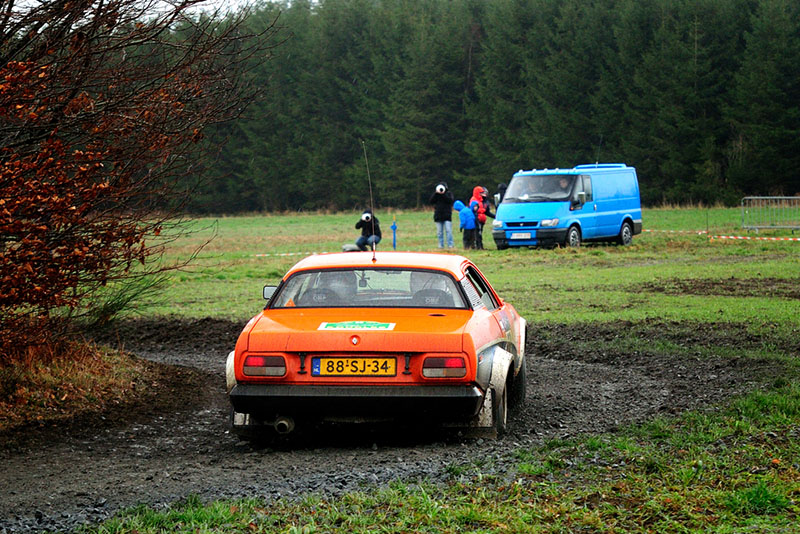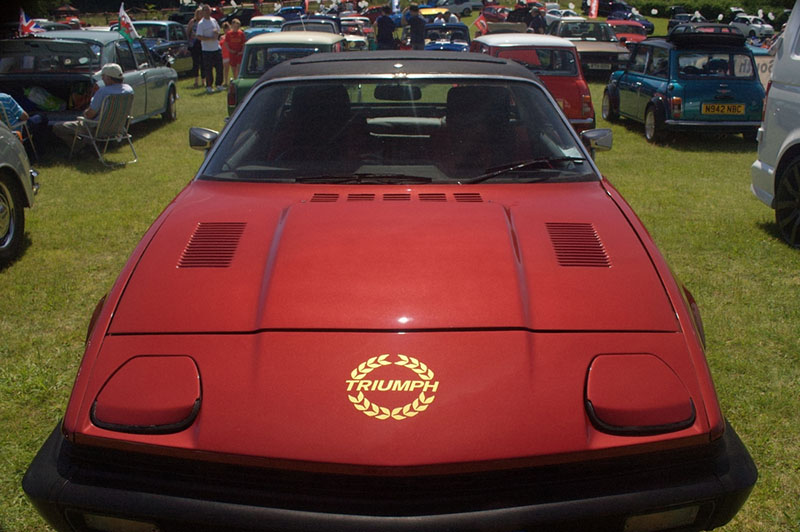Overview
Manufacturer
Triumph Motor Company, British Leyland Motor Corporation
Production
1975–1981
112,368
(TR7 coupe/hardtop)
28,864
(TR7 cabriolet/roadster)
2,497 (TR8)

Technical Information
Assembly
Speke, Liverpool, England
Canley, Coventry, England
Solihull plant, Solihull, England
Designer
Harris Mann
Body and chassis
Class
Sports car
Body style
2-door roadster
2-door coupé
Layout
FR layout
Related
Powertrain
Engine
1,998 cc (2.0 l) I4. 105 hp (78 kW) @ 5500 rpm, 119 ft lb (161 Nm) @ 3500 rpm
Transmission
4-speed manual
5-speed manual
3-speed automatic
Dimensions
Wheelbase
85 in (2,159.0 mm)
Length
160 in (4,064.0 mm)
Width
62 in (1,574.8 mm)
Height
50 in (1,270.0 mm) (coupé)
Curb weight
2,427 lb (1,101 kg) (coupé)
Chronology
Predecessor
Triumph TR6
The Triumph TR7 is a sports car that was manufactured from September 1974 to October 1981.
It was built by the Triumph Motor Company (which was part of British Leyland) in the United Kingdom.
It was initially produced at the Speke, Liverpool factory.
It moved to to Canley, Coventry in 1978 and then to the Rover Solihull plant in 1980.
The car was launched in the United States in January 1975, with its UK home market debut in May 1976.
The UK launch was delayed at least twice because of high demand for the vehicle in the US, with final sales of new TR7s continuing into 1982.
Characteristics
The car is characterised by its “wedge” shape.
It was advertised as: “the shape of things to come”
It had a swage line sweeping down from the rear wing to just behind the front wheel.
The design was penned by Harris Mann who also designed the wedge-shaped Princess.
The car has an overall length of:
- 160 inches (406 cm)
- Width of 66 inches (168 cm)
- Wheelbase of 85 inches (216 cm)
- Height of 49.5 inches (126 cm).
The coupé has a kerbside weight of 2205 pounds (1000 kg).
During development, the TR7 was referred to by the code name “Bullet”.
The original full size model wore MG logos because it was styled at Longbridge, which was not a Triumph factory.
Engine
Power is provided by a 105 bhp (78 kW) (92 bhp or 69 kW in the North American version) 1,998 cc eight-valve four-cylinder engine that shares the same basic design as the Triumph Dolomite Sprint engine
It was mounted in-line at the front of the car.
The features included:
- Drive is to the rear wheels via a four-speed gearbox initially with optional five-speed manual gearbox three-speed automatic from 1976.
- The front independent suspension uses coil spring and damper struts and lower single link at the front, and at the rear is a four-link system, again with coil springs.
- There are front and rear anti-roll bars, with disc brakes at the front and drums at the rear.
Revisions
The interior trim was revised in March 1977
It now had:
- Broadcord seat covers being replaced with red or green “tartan” check inserts with black leather effect vinyl edging.
- The tartan trim is also reflected in the door cards in padded matching red or green tartan cloth inserts in the black leather effect vinyl
The development of the convertible version of the TR7 required the interior light, which was in the headlining, to be removed.
This was replaced by lights with integral switches in each of the door cards
A map light, mounted between the seats on the back panel below the rear parcel shelf, was deleted.
The convertible also required:
- A smaller fuel filler cap as the deck area in front of the boot lid was reduced to allow for the stowage of the hood.
These modifications were also applied to the hard top for the 1978 year model (starting after the factory’s summer shutdown in 1977), presumably to maintain commonality of parts on the assembly line.
The wheel trims were also changed at this time, from smaller black trims that covered only the centre of the wheels, to larger silver ones, covering the whole wheel
However, only a small number of 1978 year model cars, with the smaller filler cap and lights in the door cards, were produced at Speke, due to the industrial action there in 1977-78.
The development of a V8 engined version, which became the Triumph TR8, required an addition bulge in the bonnet, to clear the carburettors.
This produced the “double bulge” or “double bump” bonnet, characteristic of TR7s and TR8s built at Canley and Solihull.
However, at least some of the TR7s built at Canley have:
- Single bump bonnets
It is possible these were cars that had not been completed at Speke, possibly due to the industrial action there, and finished off at Canley after production was moved
During production at Canley, the seat trim was again revised
It had:
- A plaid cloth in navy blue or tan, with matching coloured leather effect edging, and matching door cards.
A further trim change during production at Solihull saw the use of a:
- Ruched velour in blue or tan on the seats, with matching inserts on the doors.
Also, the internal door lock buttons were changed from the earlier standard BL round ones, to rectangular buttons held on with small grub screws.
There was also a change to the trip mile counter’s reset button, which became a push type operated through the instrument “glass”.
Various British Leyland vehicles were driven by the lead characters in the British secret agent television series The New Avengers, produced between 1976 and 1977.
Amongst them was a yellow TR7 hardtop driven by the character Purdey. The car was immortalised as a children’s Dinky Toy and Revell construction kit.
Lucy Ewing drove a silver convertible on the TV show “Dallas.”
In 1978 Coca-Cola and Levi’s ran promotional competitions with the top prizes being three TR7s in special red and white Coke livery.
They also featured denim upholstery and genuine jean patch pockets on the door interiors.
Also included were a 12V fridge in the boot and a TV in the glove compartment. Two of the three Coca Cola cars are known to still exist.
Variants and derivatives
TR7 Drophead Coupé
Triumph TR7 cabriolet 1998cc Aug 1982
Because of proposed US legislation on roll-over protection at the time of its launch, the TR7 was not initially available as a convertible.
In early 1979, Triumph belatedly introduced a convertible version, called the TR7 Drophead Coupé (DHC),
It first went on sale in the US (the original hardtop model being known as the Fixedhead Coupé, or FHC).
A small number of pre-production cars were manufactured at Speke in 1978, soon after the pre-production TR7 V8 (later designated TR8) and TR7 Sprint cars.
The British market received it in early 1980. The prototype for the convertible version of the original Harris Mann design came from Michelotti and the engineering to make it work was done by Triumph.
TR8
For export to the US market, Triumph created a much more powerful Triumph TR8 model in 1977/78, which was a TR7 with a 135 bhp (101 kW) 3.5 L Rover V8 engine.
While some genuine TR8 models stayed in Britain, these examples are exceedingly rare.
Most TR8s went to the US, where they did not fare well due to both Triumph’s poor build quality at the time and the unusually strong pound which peaked at around $2.40 by 1980, making Triumphs fairly expensive compared to competitors.
Spider
In 1980, a limited edition version of the TR7 Drophead was launched for the US market by the US importer. It was called the TR7 Spider.
It was available only in Maraschino Black, with reflective red striping and badging plus black interior trim
It had:
- Alloy wheels and the steering wheel from the TR8 were fitted
- A “pewter grey” carpet and grey striped upholstery
1,070 carbureted Spiders were built at the Solihull factory
An additional 548 fuel-injected (Bosch L-jetronic) Spiders built specifically for California.
VIN numbers for Spiders run from 400301 to 401918 overall and for the fuel-injected version from 401374 to 401918.
All the Spider-specific equipment was installed at the factory, with the exception of the radio/cassette, which was stored in the boot and installed at the port of entry.
TR7 Sprint
A variant of the TR7 powered by the Dolomite Sprint engine (dubbed the TR7 Sprint) was developed, but never put into full production
British Leyland had the 16-valve engined TR7 homologated for use in competition.
These cars can be identified by a different chassis number to the production 8-valve model: prefixed ACH rather than ACG, etc.
The original engines are also numbered with the format CHnnnHE, rather than the VAnnnnHE format of Dolomite 16 valve engines.
Production records at the British Motor Industry Heritage Trust (BMIHT) cover 58 prototype and pre-production cars.
All Fixedheads, built between February and October 1977.
Another car, without production records, is identified by DVLA details
There is the the possible existence of two more has been inferred from the commissioning number sequence; making a possible maximum of 59 to 61 cars.
Speke
These cars were built at the BL plant at Speke including a run of about 30 cars built on the line during the factory changeover to the 1978 year model in June 1977.
However, it is claimed that some cars at least were converted at Canley from completed TR7s built at Speke.
Production of the TR7 Sprint stopped with the closure of the Speke Plant, following labour problems there.
TR7 Sprint
However, the failure of the TR7 Sprint to go into full series production is also blamed on BL’s Sales and Marketing Department because they claimed its performance was not sufficiently different from the TR7
It’s top speed and 0-60 time were almost identical to those for the US specification carburettor version of the 3.5 litre 135 bhp Rover V8 powered Triumph TR8.
Also, the Sprint engine was unsuitable for the emission control equipment necessary for sale in the US, which was Sales and Marketing’s main target market for the TR7 and TR8.
Even so, BL required some, probably about 50, 16-valve engined TR7s suitable for normal sale before the end of 1977.
This was for the re-homologation of the 16-valve head to allow the 16-valve TR7 rally car to be used in the 1978 season following a chgange to the FIA’s rules.
That the TR7 Sprint was used in this is shown by a series of 6 photographs in the British Motor Museum’s archives, taken on the 1st of November and listed as TR7 Sprint Homologation.
The 16-valve head was approved for use with the Group-4 rally car a second time in February 1978 in time for the Mintex Rally.
Converting a two-valve TR7 to the four-valve Sprint specification is relatively simple, compared to conversion to TR8 specification, because the TR7 and TR7 Sprint have virtually identical engine blocks.
As a result, there are a number of such converted TR7 models around
1978 Triumph TR7 (Project Lynx) Heritage Motor Centre, Gaydon
While the TR7 was under development in the early 1970s, a 2+2 fastback derivative, codenamed Lynx was also planned.
The Lynx had:
- A wheelbase stretched by 12 inches (300 mm), the Rover V8 engine,
- The rear axle from the Rover SD1.
Scheduled for launch in 1978, the Lynx was cancelled when the Speke factory was closed.
Broadside
In early 1979, a joint MG/Triumph project to produce a new sportscar based on the TR7 was started under the name Project Broadside.
This was based on the TR7, with a wheelbase stretched by 5 inches (130 mm), with either an O-Series or Rover V8 engine, and both drophead and fastback body styles.
Project Broadside was cancelled later in 1979, due to a lack of funding.
Examples of both Lynx and Broadside can be seen at the BMIHT, Gaydon, England.
Boxer
During the latter part of 1979, as an exercise in badge engineering, another MG version of the TR7 was developed under the codename Boxer as a potential replacement for the MGB.
Various concepts were presented and ultimately a design from BL’s American headquarters at Leonia was accepted.
Major changes to the standard TR7 Hardtop were the addition of a MG-type grille to the nose panel, headlights similar to those of a Porsche 928 and a new tail panel with light units from a Rover SD1.
The proposal was ultimately rejected on the grounds that the car was insufficiently different from the TR7.
Motorsports
A V8-equipped TR7 rally car at the British Motoring Heritage museum.
British Leyland ran a team of TR7s in rally competitions from 1976 to 1980. They were reasonably successful on tarmac events but were less successful on gravel sections.
The 16-valve engined TR7 rally car was homologated for group 4 in October 1975, well before any 16-valve TR7 Sprints are known to have been produced.
As well as alternative cylinder heads with different numbers of cams and valves, this list of optional equipment also included:
- Many other engine, suspension, and transmission components
- Covering the use of the 4-speed, close-ratio gearbox and overdrive from the Triumph Dolomite Sprint
- The heavy duty axle from the 5-speed TR7 was initially homologated for group 3 by another, less clear, route, though re-homologated later, presumably on production of 5-speed TR7s.
Further modifications included:
- The larger front brakes
- Rear disk brakes were covered
In 1975, Appendix J listed yet more modifications allowed, with restrictions, to cars for group 4, including:
- Pistons
- Manifolds
- Carburettors
- Suspension, etc.
However, the BL rally team had to regain approval for the 16-valve head for the 1978 season, and several others such as Lancia, Toyota, Vauxhall, and Ford had similar problems at that time.
However, several other similar modifications of the era, including the Vauxhall Chevette HSR, Porsche 924 Carrera GTS, and possibly Ford RS rally cars, involved production of batches of 50 cars. This may explain, at least in part, the production of the 60 or so 16-valve TR7 Sprints in 1977.
The V8 version was homologated on 1 April 1978.
The TR8
This was homologated as a separate model, the TR8, directly into group 4, but because the TR8 had not yet been launched.
At that time, appendix J required 400 cars suitable for “normal sale”.
However, the number produced by April 1978 is believed to have been less than 150.
Journalist and historian Graham Robson says, “A lot of fast and persuasive talking then went on, to show that the makings of well over 500 cars were either built, partly built, or stuck in the morass of the Speke strike—the result being that homologation was gained.”
Quality problems
Quality problems tended to undermine the car’s image in the market place.
This was primarily the result of:
- The poor relations between management and workforce
- Frequent strikes at the Speke factory near Liverpool.
Quality improved when production was moved to the Canley plant in Coventry, and later Solihull, however it was too late to save the car’s reputation.
In its Frankfurt Motor Show preview edition of September 1977, the German magazine Auto, Motor und Sport reported that the engine of a TR7 press car had given up the ghost and “started to boil” while undergoing a maximum speed measurement exercise over a 4 km (2.5 miles) stretch of track as part of a road test.
In total approximately:
- 115,000 TR7 models were built
- 28,864 soft top/convertibles
- And approximately 2,800 TR8 models.
As part of a rationalization introduced by BL boss Sir Michael Edwardes, the Triumph TR7 was axed in 1981 when the Solihull factory ceased making cars.

